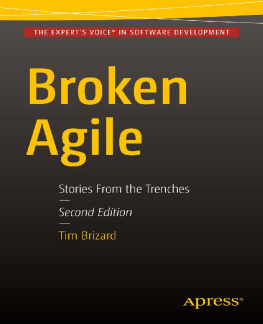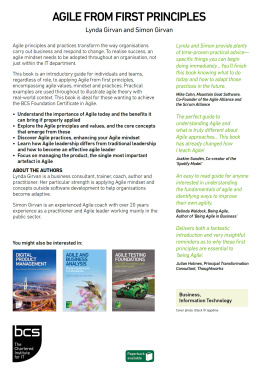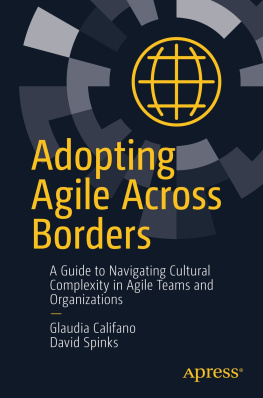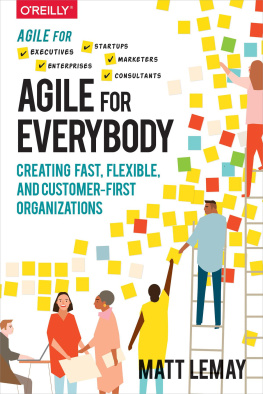
BROKEN AGILE
STORIES FROM THE TRENCHES
______________
Second Edition
Tim Brizard

Broken Agile: Stories from the Trenches
Copyright 2015 by Tim Brizard
This work is subject to copyright. All rights are reserved by the Publisher, whether the whole or part of the material is concerned, specifically the rights of translation, reprinting, reuse of illustrations, recitation, broadcasting, reproduction on microfilms or in any other physical way, and transmission or information storage and retrieval, electronic adaptation, computer software, or by similar or dissimilar methodology now known or hereafter developed. Exempted from this legal reservation are brief excerpts in connection with reviews or scholarly analysis or material supplied specifically for the purpose of being entered and executed on a computer system, for exclusive use by the purchaser of the work. Duplication of this publication or parts thereof is permitted only under the provisions of the Copyright Law of the Publishers location, in its current version, and permission for use must always be obtained from Springer. Permissions for use may be obtained through RightsLink at the Copyright Clearance Center. Violations are liable to prosecution under the respective Copyright Law.
ISBN-13 (pbk): 978-1-4842-1744-3
ISBN-13 (electronic): 978-1-4842-1745-0
Trademarked names, logos, and images may appear in this book. Rather than use a trademark symbol with every occurrence of a trademarked name, logo, or image we use the names, logos, and images only in an editorial fashion and to the benefit of the trademark owner, with no intention of infringement of the trademark.
The use in this publication of trade names, trademarks, service marks, and similar terms, even if they are not identified as such, is not to be taken as an expression of opinion as to whether or not they are subject to proprietary rights.
While the advice and information in this book are believed to be true and accurate at the date of publication, neither the authors nor the editors nor the publisher can accept any legal responsibility for any errors or omissions that may be made. The publisher makes no warranty, express or implied, with respect to the material contained herein.
Managing Director: Welmoed Spahr
Lead Editor: Steve Anglin
Editorial Board: Steve Anglin, Louise Corrigan, Jonathan Gennick, Robert Hutchinson, Michelle Lowman, James Markham, Susan McDermott, Matthew Moodie, Jeffrey Pepper, Douglas Pundick, Ben Renow-Clarke, Gwenan Spearing
Coordinating Editor: Mark Powers
Copy Editor: Lori Jacobs
Compositor: SPi Global
Indexer: SPi Global
Artist: SPi Global
Distributed to the book trade worldwide by Springer Science+Business Media New York, 233 Spring Street, 6th Floor, New York, NY 10013. Phone 1-800-SPRINGER, fax (201) 348-4505, e-mail . Apress Media, LLC is a California LLC and the sole member (owner) is Springer Science + Business Media Finance Inc (SSBM Finance Inc). SSBM Finance Inc is a Delaware corporation.
For information on translations, please e-mail .
Apress and friends of ED books may be purchased in bulk for academic, corporate, or promotional use. eBook versions and licenses are also available for most titles. For more information, reference our Special Bulk SaleseBook Licensing web page at www.apress.com/bulk-sales .
Any source code or other supplementary materials referenced by the author in this text is available to readers at www.apress.com/9781484217443 . For detailed information about how to locate your books source code, go to www.apress.com/source-code/ .
This book is dedicated to all the developers that work day in and day out to produce quality software that delivers value to the business and makes peoples lives better. Your long hours, dedication to craft, and ability to get the job done despite all challenges is a source of inspiration.
Contents
About the Author
Tim Brizard is a software engineer in Orlando, Florida. He has designed and developed enterprise-level systems since 1997. His experience includes architecting solutions for small and large companies alike. He started his career using programming languages such as C, COBOL, and RPG. Later he started to use object-oriented languages such as C++ and Java. He has a comprehensive knowledge of object-oriented languages, distributed computing, and database solutions. His architecture experience ranges from simple client-server to n-tier applications. He has a passion for software delivery and teaching others about improving the quality of software.
Acknowledgments
My completion of this book could not have been accomplished without the support of all those that I have been fortunate enough to work with over the years. To my loving family and great friends, your help and thoughtful support were truly appreciated.
CHAPTER
Introduction
I am going to begin with a few comments about the purpose of this book and what went into writing it.
The book is based on more than six years of working on several projects using Agile software development methodology. These projects began at several different companies, across several industries, and varied in size from small to extremely large.
This volume is a set of perspectives and stories from the trenches of these Agile projects based on my experiences as a senior software engineer, a technical lead, and an automation engineer.
It is as much a telling of what can go wrong using Agile as it is a guide on how to avoid land mines.
The purpose of the book is not to point out mistakes by management or others. Rather, it is told from the standpoint of people who had to deal with decisions made by managers and how better planning and understanding could have gone a long way. It is definitely an opinionated view, and I do not claim here to have all the answers. By sharing these stories and perspectives, ideally, some development teams may be spared the headaches and frustration that Ive seen.
Heres a note about the format. Each chapter outlines a specific challenge and then provides some real-life stories that illustrate these challenges. However, these stories are not just about negative experiences. There are also some positive stories that demonstrate how the challenges were handled well. Finally, for each story I provide some advice on how to avoid the same pitfalls or, in the case of positive stories, point out what can be emulated.
This is not strictly a book on Agile software development. It talks more broadly about how managements decisions can really hurt morale, contribute to terrible code quality, and ultimately cause the best employees to seek opportunities elsewhere. While knowledge of Agile software development is not a requirement to read this book, it will make understanding some of the stories and terminology easier.
So, who should read this book? Well, our readers could be anyone who has been involved in Agile projects, or development projects in general, who would like to hear about what is happening in other companies, or anyone who is looking for some advice on how to improve the process of adopting Agile in his or her company. Finally, some developers may simply enjoy reading this book because they can relate to the stories.
CHAPTER
Scale Success
Scaling is always a difficult challenge; whether it is in manufacturing, in growing a small business, or in software development. For organizations that are trying to adopt the Agile software development methodology, successfully scaling presents some unique challenges. Often scaling too quickly leads to problems that people blame on Agile. In reality, the problems could have been avoided, or at least mitigated, if more upfront planning had been done. This chapter looks at what can happen when an organization scales its Agile teams without learning from the success stories of other Agile teams.
Next page









